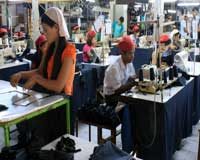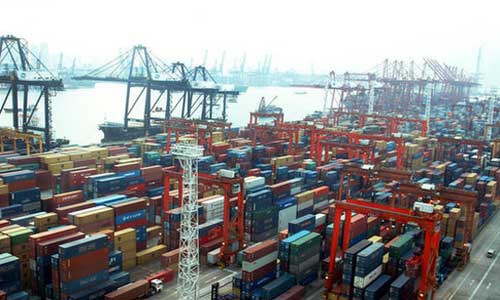"Hong Kong’s textile exports seen degrowth lately. In 2016, it fell 13 per cent and now another 7 per cent in the first five months of 2017. Re-exports, accounting for more than 99 per cent of total textiles exports, also fell 7 per cent, while domestic exports rose 2 per cent. With more than three-quarters of the textile re-exports originating from Chinese mainland, Hong Kong’s re-exports of textiles of China origin registered a decrease of 6 per cent in January-May 2017."

Hong Kong’s textile exports seen degrowth lately. In 2016, it fell 13 per cent and now another 7 per cent in the first five months of 2017. Re-exports, accounting for more than 99 per cent of total textiles exports, also fell 7 per cent, while domestic exports rose 2 per cent. With more than three-quarters of the textile re-exports originating from Chinese mainland, Hong Kong’s re-exports of textiles of China origin registered a decrease of 6 per cent in January-May 2017.

Asia accounted for 93 per cent of Hong Kong’s textile exports in the first five monthsof 2017. Other major export markets of Hong Kong textiles include Vietnam, Bangladesh, Cambodia, Indonesia, Sri Lanka, the US, India, Thailand and the Philippines. In particular because of Vietnam’s cheap labour compared to neighbouring countries and WTO membership, many foreign investors, including those from Hong Kong, have set up garment factories there. This gives rise to sustained demand for textile imports, making Vietnam the second largest market for Hong Kong’s textile exports, after the Chinese mainland. Talking about products, Hong Kong’s exports of knitted or crocheted fabrics, textile yarns, woven fabrics, textile made-up and floor coverings registered respective declines of 3 per cent-64 per cent in the first five months of 2017. However, finishing accessories and special yarns and fabrics increased by 3 per cent and 2 per cent, respectively, in the first five months of 2017.
Industry trends
With rising labour costs, volatile raw material prices and stringent environmental regulations on the Chinese mainland, many Hong Kong's textiles manufacturers have relocated their production facilities to other South-east Asian countries, like Vietnam, Cambodia, Myanmar and Bangladesh. A few companies have even set up offshore production in Latin America (e.g. Mexico) and Africa (e.g. Nigeria) to take advantage of preferential treatments allowed by regional trade agreements such as North American Free Trade Agreement (NAFTA) and the EU’s GSP scheme.
Product trends
Among various kinds of fibres, cotton remains the most preferred material for consumers. Cotton-rich apparel continues to attract European consumers, while consumers in China, India and Japan agree that cotton and cotton blend are the most comfortable, authentic and sustainable, compared to other man-made fibres. Microfibres are attracting textiles manufacturers as they are light in weight and have superior performance in keeping warm. These days more and more breathable, flexible, anti-bacterial, anti-ultraviolet, wrinkle-free, water-resistant and eco-friendly materials are invented and marketed. For instance, TENCEL® invented by Lenzing Group is a kind of lyocell fibre that possesses several functional advantages over cotton, while Salvatore Ferragamo has pioneered the use of sustainable fabrics made from citrus fruit.
Technovation
Technology and innovation are yet again set to rule the textile world. Fancy weaves and prints will give more flexibility in the choice of manufacturing processes, while digital prints, as well as artisanal decoration, will make textiles more malleable. Additionally, hand-crafted excellence, original visuals and exceptional handles will continue to be sought after, given consumers’ ever-growing appetite for uniqueness and distinctiveness. Solar-powered handbag made of a textile photovoltaic surface that powers a battery inside to charge a mobile phone and ‘climate costumes’ that sense changes in carbon emission with light patterns using conductive thread and LEDs are just some examples of how technical textiles are shaping the future textiles industry. As wearable technologies are becoming more accessible, technical textiles are widely applied over a wide range of industries such as automobile, aerospace, architecture, healthcare and sports. Luminescent and heated garments as well as smart knee bandages are cases in point.
Eco-consciousness
To comply with global trends of green manufacturing, more textile corporations have adopted the bluesign® standard – one of the industry’s major voluntary standards for environmental sustainability. Consumers in West Europe, the US and Japan, are stringent about the environmentally friendly properties of biodegradable natural fibres like organic cotton, soy fibre and ahimsa silk. To keep up with this trend, manufacturers have also expanded their production of green textiles by utilising more bio-degradable materials and environmentally-friendly manufacturing processes, including high-efficiency management practices, process control, special processes, and recycling of wastewater.
Product safety
Besides going green, companies are paying utmost attention on product safety. For instance, a number of disqualified apparel fibres consisting of unsatisfactory levels of pH value, formaldehyde content and banned azo dyes have been reported on the Chinese mainland in recent years. In fact, Chinese consumers are increasingly in favour of foreign apparel brands, which usually guarantee product safety. Meanwhile, in traditional markets, for example, the EU’s Rapid Alert System for Non-Food Products (RAPEX) revealed that textiles, clothing and fashion items were the third most common product category notified (behind only toys and motor vehicles), representing 13 per cent of the total number of notifications of dangerous products in 2016.












